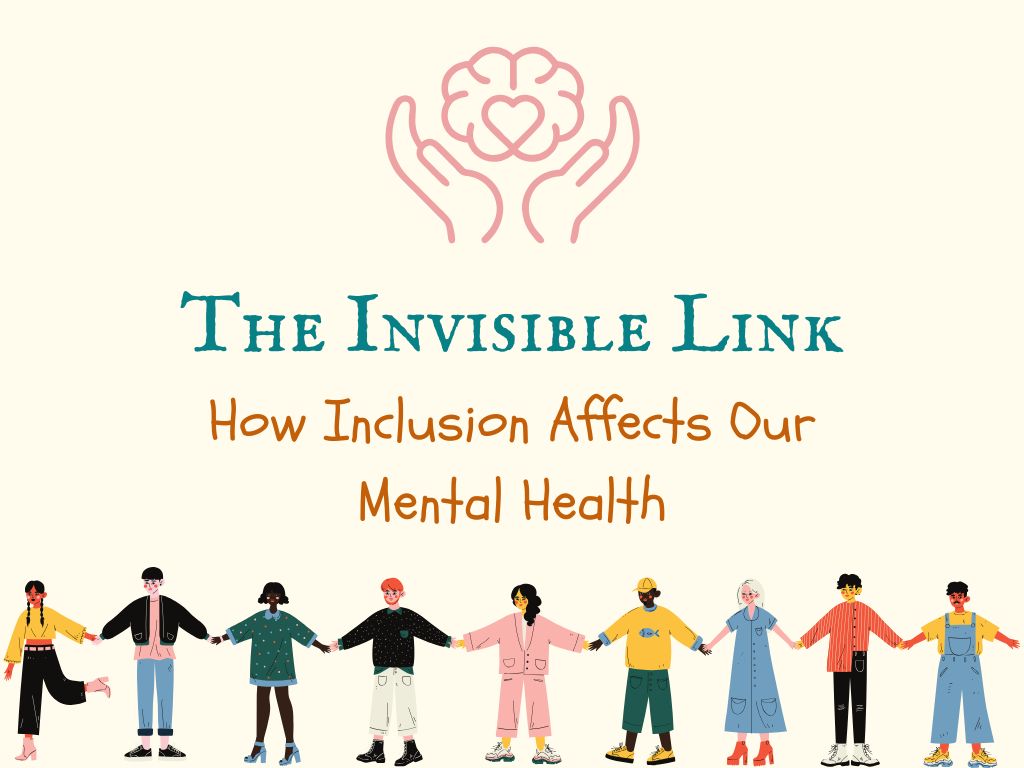This blog draws insight from several powerful research papers and reviews exploring the link between inclusion, belongingness, and mental well-being, especially from works published in journals like BMC Psychology, eLife, and the Journal of American College Health.
(A full list of references is available at the end.)
“Diversity is a fact. Inclusion is an act. But belonging, belonging is a feeling.”
In recent years, we have all become familiar with the words diversity and inclusion. Schools are trying to be more inclusive. Workplaces are rolling out diversity policies. Panels are more “balanced.” But beyond this visible effort, there lies something subtle, something deeply personal. It’s the quiet connection between inclusion and our mental well-being.
This blog is not going to re-tell you what inclusion is, you know that already. What we’re going to do is dive into something less discussed: how inclusion, or the absence of it, directly affects our psychological and emotional well-being.
Inclusion Is Not Just Policy. It’s Psychology.
Each human being has an innate need, the need to belong.
It’s not a philosophical concept; it’s a psychological fact. Maslow’s needs hierarchy puts belongingness right after our food and safety needs. When we don’t feel part of things when we are left out, not heard, or not seen it alters how we perceive ourselves and how we work emotionally.
A research conducted by Moeller, Seehuus € Peisch (2020) revealed that emotional intelligence positively impacts the mental well-being of college students directly through enhancing their sense of belonging. Included students had fewer symptoms of depression and anxiety
(Journal of American College Health, DOI: 10.1080/07448481.2020.1841774).
Psychological Safety: The Missing Piece in Most Institutions
Psychological safety is feeling safe to be yourself without fear of judgment or punishment. Harvard professor Amy Edmondson coined the term to define spaces where individuals feel safe to speak up, take risks, and be vulnerable.
In class, it looks like students asking questions openly without fear of being ridiculed. In the office, it’s coworkers offering honest feedback without second-guessing.
Inclusion builds psychological safety. Exclusion demolishes it.
And in the absence of psychological safety, anxiety, stress, and low self-esteem creep in.
A 2021 systematic review in BMC Psychology confirms this: environments in which there is high Psychosocial Safety Climate (PSC) where respect, inclusion, and emotional safety are valued have reduced burnout, depression, and emotional exhaustion. Lack of inclusion, on the other hand, is linked to greater workplace distress (BMC Psychology, 2024).
The Damage of Subtle Exclusion: Microaggressions and Tokenism Not all exclusion is loud. Sometimes it whispers.
It looks like:
- Being complimented for speaking “good English” as if it’s unexpected.
- Being the only woman in the room and expected to represent “all women.”
- Having your name constantly mispronounced even after corrections.
These subtle acts are called microaggressions. They chip away at our confidence. Over time, they create emotional fatigue, stress, and even symptoms of trauma.
In accordance with a research study in the Journal of Counseling Psychology (2021), microaggressions strongly relate to increased anxiety, depressive symptoms, and low academic motivation in students of color.
Intersectionality and Emotional Load
Some of us have more than one identity that’s been historically marginalised such as a Dalit queer student or a Muslim woman in a corporate company.
This is where intersectionality enters the picture, a term Kimberlé Crenshaw helped popularise. It is a reminder that individuals’ challenges are not singular. The mental load escalates when several aspects of your identity are experiencing exclusion simultaneously.
In a 2022 eLife study, marginalised racial and gender group doctoral medical students said they experienced much greater mental distress amid the double crises of COVID-19 and racial injustice protests, pointing to the mental toll of exclusionary settings (Schad et al., 2022).
Inclusion Lowers Mental Load Particularly for Neurodivergent and Marginalised People
Let’s think about inclusive design such as readable fonts, quiet rooms, content in local languages, gender-neutral forms, or emotional regulation graphs in classrooms.
These are not accessibility features. They are mental health tools.
They assist individuals in concentrating, being less anxious, and engaging more. In classrooms, this empowers kids with ADHD or dyslexia. In workplaces, it assists workers with anxiety or sensory sensitivity.
In an international review of inclusive education and cognitive load, inclusive classroom students reported greater motivation and less stress (European Journal of Psychology of Education, 2021).
Inclusion is Emotional Safety
Being noticed without screaming. Being heard without needing to yell. Being accepted without needing to shrink or perform.
When inclusion is actually put into practice:
- Students feel more assured in class.
- Employees open up and innovate more.
- Individuals arrive not only with talent, but with heart.
Inclusion demands: You don’t have to check pieces of yourself at the door. You are welcome here exactly as you are.
And in itself, that is a form of healing.
Let’s Not Forget
We don’t build inclusive systems because it makes us look progressive.
We build them because inclusion honest-to-goodness, day-in, day-out, human inclusion is a type of mental health treatment.
Let’s approach it that way.
References
Moeller, J., Seehuus, M., & Peisch, V. (2020). Emotional intelligence, belongingness, and mental health in college students. Journal of American College Health. https://doi.org/10.1080/07448481.2020.1841774
BMC Psychology. (2024). The role of psychosocial safety climate in protecting psychological health during the pandemic.
Nadal, K. et al. (2021). Microaggressions and mental health: A meta-analysis. Journal of Counseling Psychology. https://doi.apa.org/doi/10.1037/cou0000536
Schad, E. et al. (2022). Mental health of biomedical doctoral students during the pandemic and racial justice movements. eLife.
European Journal of Psychology of Education. (2021). Cognitive load and inclusive pedagogy: Lessons from classroom research.

Comments are closed